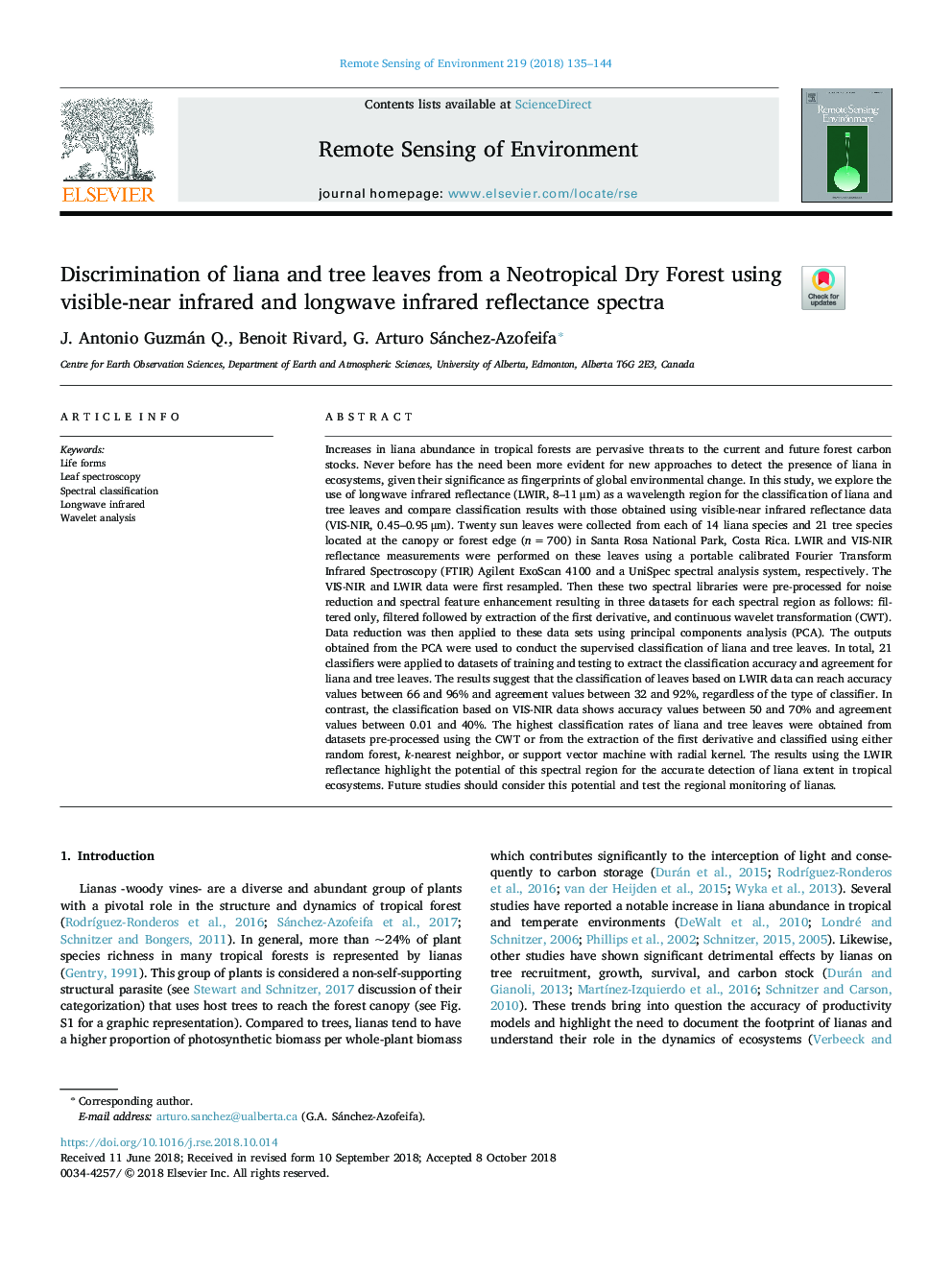| کد مقاله | کد نشریه | سال انتشار | مقاله انگلیسی | نسخه تمام متن |
|---|---|---|---|---|
| 11262732 | 1840469 | 2018 | 10 صفحه PDF | دانلود رایگان |
عنوان انگلیسی مقاله ISI
Discrimination of liana and tree leaves from a Neotropical Dry Forest using visible-near infrared and longwave infrared reflectance spectra
ترجمه فارسی عنوان
تبعیض از لیانا و برگ های درخت از یک جنگل خشک نئوتروپیک با استفاده از طیف های انعکاسی مادون قرمز نزدیک مادون قرمز و طول موج
دانلود مقاله + سفارش ترجمه
دانلود مقاله ISI انگلیسی
رایگان برای ایرانیان
کلمات کلیدی
موضوعات مرتبط
مهندسی و علوم پایه
علوم زمین و سیارات
کامپیوتر در علوم زمین
چکیده انگلیسی
Increases in liana abundance in tropical forests are pervasive threats to the current and future forest carbon stocks. Never before has the need been more evident for new approaches to detect the presence of liana in ecosystems, given their significance as fingerprints of global environmental change. In this study, we explore the use of longwave infrared reflectance (LWIR, 8-11â¯Î¼m) as a wavelength region for the classification of liana and tree leaves and compare classification results with those obtained using visible-near infrared reflectance data (VIS-NIR, 0.45-0.95â¯Î¼m). Twenty sun leaves were collected from each of 14 liana species and 21 tree species located at the canopy or forest edge (nâ¯=â¯700) in Santa Rosa National Park, Costa Rica. LWIR and VIS-NIR reflectance measurements were performed on these leaves using a portable calibrated Fourier Transform Infrared Spectroscopy (FTIR) Agilent ExoScan 4100 and a UniSpec spectral analysis system, respectively. The VIS-NIR and LWIR data were first resampled. Then these two spectral libraries were pre-processed for noise reduction and spectral feature enhancement resulting in three datasets for each spectral region as follows: filtered only, filtered followed by extraction of the first derivative, and continuous wavelet transformation (CWT). Data reduction was then applied to these data sets using principal components analysis (PCA). The outputs obtained from the PCA were used to conduct the supervised classification of liana and tree leaves. In total, 21 classifiers were applied to datasets of training and testing to extract the classification accuracy and agreement for liana and tree leaves. The results suggest that the classification of leaves based on LWIR data can reach accuracy values between 66 and 96% and agreement values between 32 and 92%, regardless of the type of classifier. In contrast, the classification based on VIS-NIR data shows accuracy values between 50 and 70% and agreement values between 0.01 and 40%. The highest classification rates of liana and tree leaves were obtained from datasets pre-processed using the CWT or from the extraction of the first derivative and classified using either random forest, k-nearest neighbor, or support vector machine with radial kernel. The results using the LWIR reflectance highlight the potential of this spectral region for the accurate detection of liana extent in tropical ecosystems. Future studies should consider this potential and test the regional monitoring of lianas.
ناشر
Database: Elsevier - ScienceDirect (ساینس دایرکت)
Journal: Remote Sensing of Environment - Volume 219, 15 December 2018, Pages 135-144
Journal: Remote Sensing of Environment - Volume 219, 15 December 2018, Pages 135-144
نویسندگان
J. Antonio Guzmán Q., Benoit Rivard, G. Arturo Sánchez-Azofeifa,
